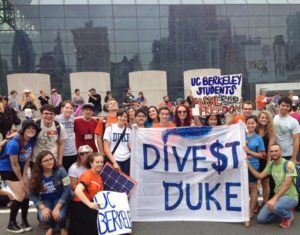Climate change is here to stay, and the window of opportunity to avert its worst effects is closing.
One of the reasons that climate change is such an important issue to us at Climate Defense Project is that it’s not just about science, or politics, or what happens in the distant future. It’s about justice for people here and now. Climate change is a threat multiplier, which means it compounds existing social and humanitarian problems, including food insecurity and geopolitical instability. In the United States, we have already seen that poor communities and communities of color suffer the brunt of the impacts of extreme weather events such as hurricanes and heat waves. We must also grapple with the issues of intergenerational (in)justice raised by rising seas and collapsing ecosystems.
The legal system can and must form part of the solution. It isn’t just that the climate movement needs the legal system, though the movement certainly does need new legal tools, new rights-based paradigms, and a broader support apparatus to provide advice, representation, and overall legal strategy. The legal system also needs the climate movement. Courts and other legal institutions block or ignore democratic forces calling for action on climate change at the risk of becoming irrelevant to one of the major social struggles of our era—and, more broadly, legal institutions depend for their mandate on a certain amount of responsiveness (even if indirect) to public sentiment. By supporting the movement and channeling its energy into the legal system, lawyers can play an essential role in bridging the gap between climate politics and climate law.
At least three projects will be essential in the years ahead:
- Action by individuals with adequate legal support. Action by individuals and civil society groups—not just government—is required to create a fully-fledged movement capable of opening up space for transformative political change and encouraging policymakers to view climate change as a social justice issue. Most Americans already support action to combat climate change, and as climate harms become more pervasive, that support will likely grow. With legal representation and a clear legal strategy, more people will be willing to join the movement.Individuals practicing nonviolent direct action and drawing inspiration from the Civil Rights Movement of the 1960s, among other campaigns, have already been remarkably successful in halting or delaying new fossil fuel construction, extraction, and exploration. Moreover, interest in direct action is on the rise: A 2013 survey by researchers at Yale University reported that one in eight Americans would be willing to engage in civil disobedience to combat climate change, and the Sierra Club’s board of directors recently endorsed it for the first in its history. But existing activist defense organizations have limited capacity to accommodate increased clientele, and virtually no legal organizations cater exclusively to climate activists and campaigners. There is a very large unmet need for lawyers who understand the movement’s goals and tactics and are willing to advise clients before, during, and after their protest activities.
- New legal theories. New legal theories are desperately needed to challenge the continued extraction of fossil fuels and the failure of state and national governments to respond to climate harms. Recent efforts to invoke the climate necessity defense have generated excitement in the legal community but are not being replicated as part of a coordinated, national campaign. New legal theories are also needed to avoid the causation difficulties that have plagued earlier climate litigation efforts, while still other theories are needed to sidestep perennial difficulties related to standing or the political question doctrine. All such theories would, ideally, be available to individual plaintiffs and not dependent on government action.
- Connections between legal and activist communities. Sustained and coordinated efforts must be made to connect climate activists with attorneys, legal workers, and others from the legal community. The two communities currently work in relative isolation from one another, and yet there is enormous potential for cross-pollination between them. Bringing together lawyers and activists will require regular meetings (from informal gatherings to networking events to conferences) with experts from both communities. It will also require bringing together lawyers themselves to enable knowledge-sharing about the unique needs of the climate movement and the wishes of climate activist clients.
We are in the eleventh hour, and some irreversible changes are already locked in. But we still have a narrow window in which to act, and act we must. Fifty years ago, there were no environmental lawyers and the environmental movement was in its infancy. We’re in a similar moment now. As the climate movement hits its stride, it’s time for lawyers to rally around it.





